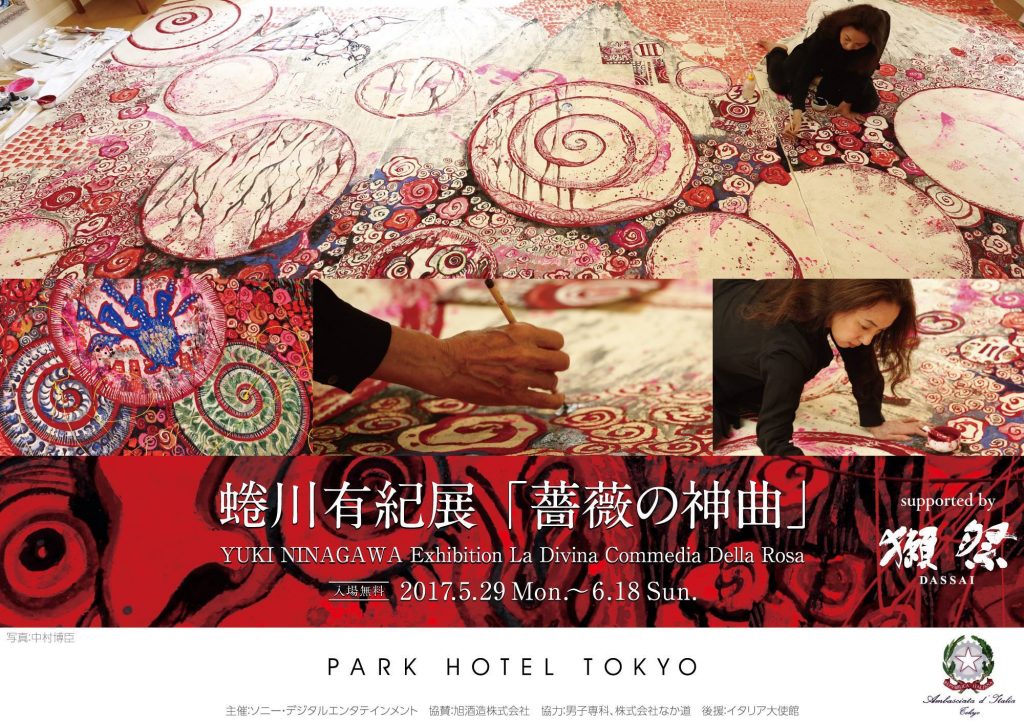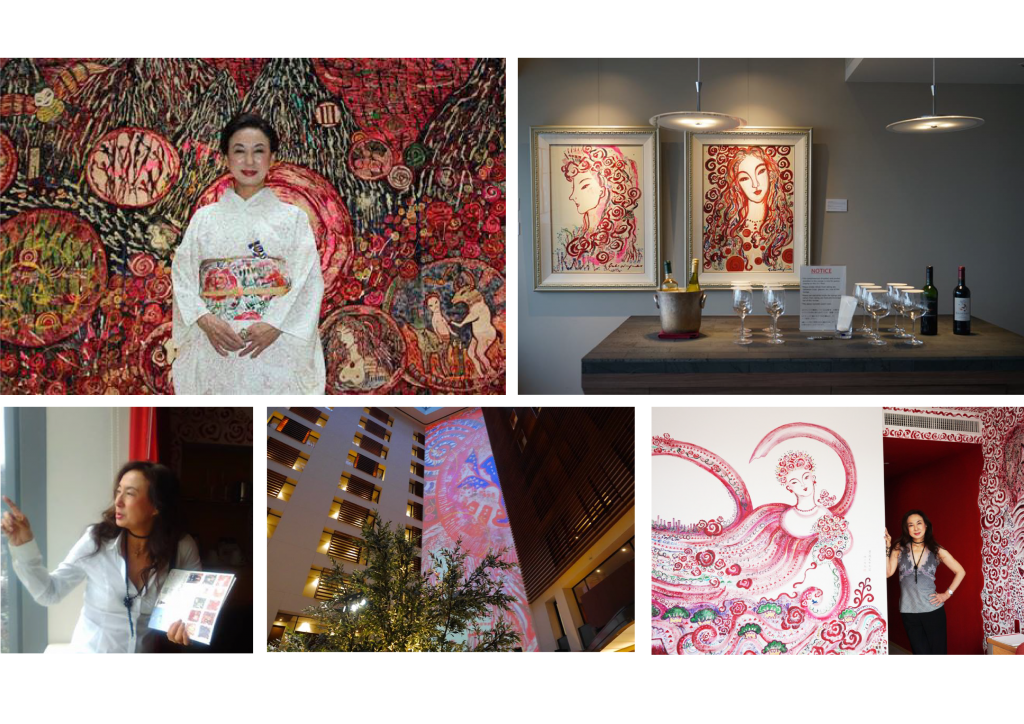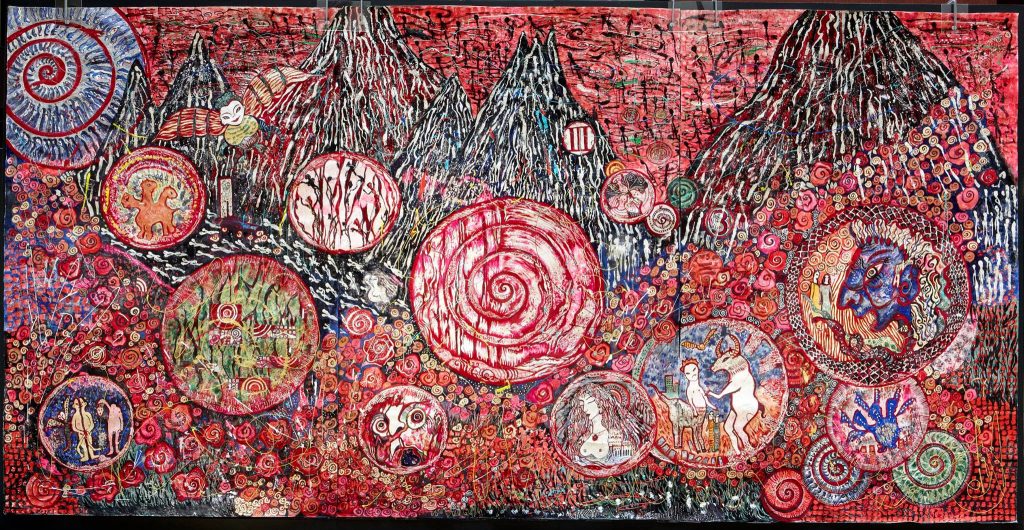YUKI NINAGAWA Exhibition
-La Divina Commedia della Rosa-
【日本語】
Yuki Ninagawa will be exhibiting a set of new works themed around Inferno from Dante’s Divine Comedy, all of which have been composed in a color palette of red and blue. The exhibition will include “Rose of Beatrice”—based on Dante’s take on the eternal feminine, “Mount Purgatory”, and of course “L’inferno di rosa”—an epic three by six meter artwork created using natural mineral pigments over the course of 18 months. The ART Lounge of Park Hotel Tokyo will be dripping in the dark world of the Divine Comedy!
Enjoy the three canticas of Dante’s Divine Comedy (Hell, Purgatory, and Heaven) as you take in the works exhibited on the Artist Floor (31F), and the dynamic image projected onto a wall on the 25th floor, stretching up to 30 meters in length (evening only). What’s more, you will also get the chance to see a representative selection of Yuki Ninagawa’s existing body of work.
Period/May 29th, 2017 〜 June 18th
Place/PARK HOTEL TOKYO
Presented by Sony Digital Entertainment Services, Inc.
In Association with Danshi Senka Co., Ltd.
Sponsored by Asahishuzo Co., Ltd.
Assisted by WATER DESIGN Co., Ltd., Nakamichi Co., Ltd., Millesimes Inc., mieuse Co., Ltd.
Special Assistance of PARK HOTEL TOKYO
Under the auspice of Embassy of Italy in Japan
I wanted to paint our shared ancent “deep straum”of consciousness, something that went beyond notions of time, space, and ethnicity.”
“In the summer, a couple of years back, I was thinking about the world in which we live… war, disaster, terrorism, refugees, nuclear contamination…I was thinking about just how are we supposed to survive all this? I spread out all the books I had read to date on the table, and began to think long and hard. After spending about a month reading, the ‘answer’ suddenly popped into my head.”
2017.june
by Yuki NINAGAWA
“The artist of ’Rose’, Yuki Ninagawa, challenges Dante’s Divine Comedy!”
It almost feels like an unexpected leap forward. But, in thinking about the composition of the grand finale that is ‘Heaven’, the piece which suggests the grate aspect of the Rose. this ‘leap forward’ by the artist could be understood as something entirely natural. A number of artists, from Giotto or Botticelli, have tried their hand at visualising Dante’s work full of metaphors, symbols, and allegories, but Doré’s works seem to have been the most successful At any rate, this ‘leap forward’ by the sheer force of will of the artist of the ‘Rose’ is something we should look out for.”
by Atsushi Tanigawa (Aesthetician)
[Archaic Beauty] Michifumi Isoda (Historian)
The awe-inspiring spirals in ‘Rose’
“I will never forget the awe I felt when I saw Yuki Ninagawa’s work for the first time.
It resembled a painting from ancient times. It was like a shaman or a spirit medium from long ago had summoned joy from deep within their hearts and smashed it all over the wall. In that rhythm, they had somehow managed to form an image.
It felt like it had been such a long time since I’d encountered such a painting. I was genuinely moved by the experience. When I was a child, only at once, I saw a painting similar to it deep within a dark place – a painting that had been drawn on the walls of an ancient burial mound from more than 1,500 years ago.
After seeing her work, I was quick to ask Ms. Ninagawa if she had ever seen the decorated Kofun tombs in Kyushu. I asked if she had ever seen the burial sites with the red-lacquered coffins which the peoples of the Himiko-era had used to pray for rebirth. When she answered that she hadn’t, I got goose bumps all over. The never-ending vortexes of Ms. Ninagawa’s ’Rose’ were just so similar to the rhythms of those paintings which decorated the walls of the Kofun burial tombs from 1,500 years ago.”
The Crimson Paints Beloved by Queen Himiko
“That’s not cinnabar sand, is it?” Ms. Ninagawa shot me an inquiring look. “Yes,” she replied. “It actually is.” I felt like I was going to faint. Cinnabar sand is a paint material containing mercury that was used in the Kofun period. Queen Himiko prized the deep crimson of this paint above all else. Because cinnabar contains mercury, it is toxic, but it does not corrode the body when used as paint. Cinnabar represented eternal life. Ms. Ninagawa, completely unconsciously, has used Queen Himiko’s cinnabar to create the spirals in her ’Rose’. Her never-ending vortexes are mystical in their very nature, having the ability to both draw you deep within and lift you high up.。
Her paintings featured scenes in which all bodies had broken down and were dissolving into one another. Their boundaries rendered meaningless, they were beguiling to behold. At first, I thought Ms. Ninagawa’s paintings were similar to those of the decorated Kofun tombs, but the more I looked at them, the more my mind began to change. I began to see that something within them was connected to the decorations of the Alhambra Palace in Spain, or the works of Chagall, or at a deeper level to the beauty of all kinds of primitive ancient art.
The Beauty of the Unconscious
It was at that point that the word ‘Archaïque’ came to mind. It was Emmanuel Todd, a French scholar who looks to current and past events to comment on future possibilities, that first brought the concept of the ‘Archaïque’ to me.
The term Archaïque is translated as ‘ancient’ or ‘primeval’. It can be used to describe an ancient unconsciousness, something that is shared at a fundamental level among the peoples of this world, regardless of nation or race. This ancient unconsciousness exists without boundaries. In the world of 2017, the concepts of religion, nationhood, and money, things which are not seen in the animal world, have created deep divisions in human society. However, Ms. Ninagawa’s paintings, just like the literature of Italo Calvino, exist unbounded by these concepts. Her paintings contain a peculiar sense of deja-vu. They make you feel as if you have already seen them before, even before you were born. They are works that make you feel unbounded by the boundaries that separate one person from the next, and by the concepts of time, space, and ethnicity.
I have no doubt that Ms. Ninagawa’s paintings already existed deep within her right from the very start, where they then grew in energy before finally gushing out. I want you to see the series of spirals featured in the looming roses of the ’Rose’. I want you to see the eyes of the creatures that exist within them. When we see an ‘Archaic Beauty’, is it not true that we feel something in our souls tremble? When I want to feel that ‘tremble,’ I go and stand in front of one of Ms. Ninagawa’s paintings.
【Main Graphic】
『L’inferno di rosa』 H300×W600cm Yuki Ninagawa 2016
【PAINTINGS & OBJECTS】
【HANGING SCROLLS】
【DRAWINGS】
☆About the artist room at PARK HOTEL TOKYO :
http://www.parkhoteltokyo.com/artcolours/aih/29ninagawa/29ninagawa_en.html
















































